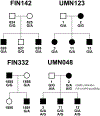The role of CDHR3 in susceptibility to otitis media
- PMID: 34322716
- PMCID: PMC8541908
- DOI: 10.1007/s00109-021-02118-7
The role of CDHR3 in susceptibility to otitis media
Abstract
Otitis media (OM) is common in young children and can cause hearing loss and speech, language, and developmental delays. OM has high heritability; however, little is known about OM-related molecular and genetic processes. CDHR3 was previously identified as a locus for OM susceptibility, but to date, studies have focused on how the CDHR3 p.Cys529Tyr variant increases epithelial binding of rhinovirus-C and risk for lung or sinus pathology. In order to further delineate a role for CDHR3 in OM, we performed the following: exome sequencing using DNA samples from OM-affected individuals from 257 multi-ethnic families; Sanger sequencing, logistic regression and transmission disequilibrium tests for 407 US trios or probands with OM; 16S rRNA sequencing and analysis for middle ear and nasopharyngeal samples; and single-cell RNA sequencing and differential expression analyses for mouse middle ear. From exome sequence data, we identified a novel pathogenic CDHR3 splice variant that co-segregates with OM in US and Finnish families. Additionally, a frameshift and six missense rare or low-frequency variants were identified in Finnish probands. In US probands, the CDHR3 p.Cys529Tyr variant was associated with the absence of middle ear fluid at surgery and also with increased relative abundance of Lysobacter in the nasopharynx and Streptomyces in the middle ear. Consistent with published data on airway epithelial cells and our RNA-sequence data from human middle ear tissues, Cdhr3 expression is restricted to ciliated epithelial cells of the middle ear and is downregulated after acute OM. Overall, these findings suggest a critical role for CDHR3 in OM susceptibility. KEY MESSAGES: • Novel rare or low-frequency CDHR3 variants putatively confer risk for otitis media. • Pathogenic variant CDHR3 c.1653 + 3G > A was found in nine families with otitis media. • CDHR3 p.Cys529Tyr was associated with lack of effusion and bacterial otopathogens. • Cdhr3 expression was limited to ciliated epithelial cells in mouse middle ear. • Cdhr3 was downregulated 3 h after infection of mouse middle ear.
Keywords: CDHR3; Expression; Microbiome; Middle ear; Otitis media; rs6967330.
© 2021. The Author(s), under exclusive licence to Springer-Verlag GmbH Germany, part of Springer Nature.
Conflict of interest statement
Figures



References
-
- Brennan-Jones CG, Whitehouse AJ, Park J, Hegarty M, Jacques A, Eikelboom RH, Swanepoel DW, White JD, Jamieson SE (2015) Prevalence and risk factors for parent-reported recurrent otitis media during early childhood in the Western Australian Pregnancy Cohort (Raine) study. J Paediatr Child Health 51:403–409. - PubMed
-
- Su JY, Guthridge S, He VY, Howard D, Leach AJ (2020) Impact of hearing impairment on early childhood development in Australian Aboriginal children: A data linkage study. J Pediatr Child Health 56: 1597–1606. - PubMed
-
- Bhattacharyya N, Shay SG (2020) Epidemiology of Pediatric Tympanostomy Tube Placement in the United States. Otolaryngol Head Neck Surg 163:600–602. - PubMed
Publication types
MeSH terms
Substances
Grants and funding
LinkOut - more resources
Full Text Sources
Medical
Molecular Biology Databases

